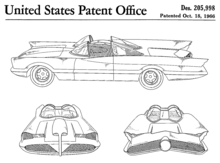Costume
Main article: Batsuit
Batman's costume incorporates the imagery of a bat in order to frighten criminals. The details of the Batman costume change repeatedly through various stories and media, but the most distinctive elements remain consistent: a scallop-hem cape, a cowl covering most of the face featuring a pair of batlike ears, and a stylized bat emblem on the chest, and the ever-present utility belt. The costumes' colors are traditionally blue and grey, although this colorization arose due to the way comic book art is colored. Finger and Kane conceptualized Batman as having a black cape and cowl and grey suit, but conventions in coloring called for black to be highlighted with blue. This coloring has been claimed by Larry Ford, in Place, Power, Situation, and Spectacle: A Geography of Film, to be a reversion of conventional color-coding symbolism, which sees "bad guys" wearing dark colors. Batman's gloves typically feature three scallops that protrude from long, gauntlet-like cuffs, although in his earliest appearances he wore short, plain gloves without the scallops. A yellow ellipse around the bat logo on the character's chest was added in 1964, and became the hero's trademark symbol, akin to the red and yellow "S" symbol of Superman. The overall look of the character, particularly the length of the cowl's ears and of the cape, varies greatly depending on the artist. Dennis O'Neil said, "We now say that Batman has two hundred suits hanging in the Batcave so they don't have to look the same . . . Everybody loves to draw Batman, and everybody wants to put their own spin on it.Equipment
See also: Batman's utility belt
Batman uses a large arsenal of specialized gadgets in his war against crime, the designs of which usually share a bat motif. Batman historian Les Daniels credits Gardner Fox with creating the concept of Batman's arsenal with the introduction of the utility belt in Detective Comics #29 (July 1939) and the first bat-themed weapons the batarang and the "Batgyro" in Detective Comics #31 and #32 (September; October, 1939). Batman's primary vehicle is the Batmobile, which is usually depicted as an imposing black car with large tailfins that suggest a bat's wings. Batman's other vehicles include the Batplane (aka the Batwing), Batboat, Bat-Sub, and Batcycle.In proper practice, the "bat" prefix (as in batmobile or batarang) is rarely used by Batman himself when referring to his equipment, particularly after some portrayals (primarily the 1960s Batman live-action television show and the Super Friends animated series) stretched the practice to campy proportions. The 1960s television series Batman has an arsenal that includes such "bat-" names as the bat-computer, bat-scanner, bat-radar, bat-cuffs, bat-pontoons, bat-drinking water dispenser, bat-camera with polarized bat-filter, bat-shark repellent bat-spray, and bat-rope. The storyline "A Death in the Family" suggests that given Batman's grim nature, he is unlikely to have adopted the "bat" prefix on his own.
Batman keeps most of his field equipment in a utility belt. Over the years it is shown to contain a virtually limitless variety of crime-fighting tools. Different versions of the belt have these items stored in either pouches or hard cylinders attached evenly around it. A typical major exception to the range of Batman's equipment are conventional firearms, which he refuses to use on principle considering that weapon class was the instrument of his parents' murder. Modern depictions of Batman have him compromise for practicality by arming his vehicles mainly for the purpose of removing obstacles or disabling enemy vehicles.
Bat-Signal
Main article: Bat-Signal
When Batman is needed, the Gotham City police activate a searchlight with a bat-shaped insignia over the lens called the Bat-Signal which shines into the night sky, creating a bat-symbol on a passing cloud which can be seen from any point in Gotham. The origin of the signal varies, depending on the continuity and medium.In various incarnations, most notably the 1960s Batman TV series, Commissioner Gordon also has a dedicated phone line, dubbed the Bat-Phone, connected to a bright red telephone (in the TV series) which sits on a wooden base and has a transparent cake cover on top. The line connects directly to Batman's residence, Wayne manor, specifically both to a similar phone sitting on the desk in Bruce Wayne's study and the extension phone in the Batcave.
Batcave
Main article: Batcave
The Batcave is Batman's secret headquarters, consisting of a series of subterranean caves beneath his mansion, Wayne Manor. It serves as his command center for both local and global surveillance, as well as housing his vehicles and equipment for his war on crime. It also is a storeroom for Batman's memorabilia. In both the comic Batman: Shadow of the Bat (issue #45) and the 2005 film Batman Begins, the cave is said to have been part of the Underground Railroad. Of the heroes and villains who see the Batcave, few know where it is located.

